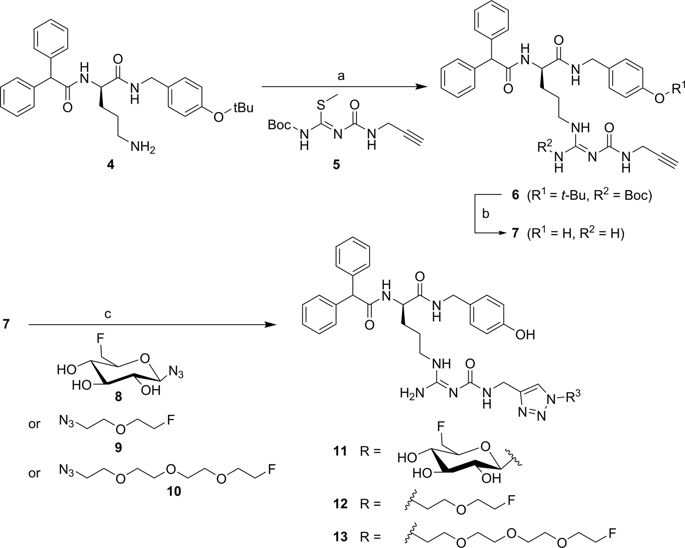Our official English website, www.x-mol.net, welcomes your
feedback! (Note: you will need to create a separate account there.)
18F-labelled triazolyl-linked argininamides targeting the neuropeptide Y Y1R for PET imaging of mammary carcinoma.
Scientific Reports ( IF 3.8 ) Pub Date : 2019-09-10 , DOI: 10.1038/s41598-019-49399-0 Simone Maschauer 1 , Julian J Ott 1 , Günther Bernhardt 2 , Torsten Kuwert 1 , Max Keller 2 , Olaf Prante 1
Scientific Reports ( IF 3.8 ) Pub Date : 2019-09-10 , DOI: 10.1038/s41598-019-49399-0 Simone Maschauer 1 , Julian J Ott 1 , Günther Bernhardt 2 , Torsten Kuwert 1 , Max Keller 2 , Olaf Prante 1
Affiliation

|
Neuropeptide Y Y1 receptors (Y1R) have been found to be overexpressed in a number of different tumours, such as breast, ovarian or renal cell cancer. In mammary carcinoma the high Y1R density together with its high incidence of 85% in primary human breast cancers and 100% in breast cancer derived lymph node metastases attracted special attention. Therefore, the aim of this study was the development of radioligands for Y1R imaging by positron emission tomography (PET) with a special emphasis on imaging agents with reduced lipophilicity to provide a PET ligand with improved biodistribution in comparison with previously published tracers targeting the Y1R. Three new radioligands based on BIBP3226, bearing an 18F-fluoroethoxy linker (12), an 18F-PEG-linker (13) or an 18F-fluoroglycosyl moiety (11) were radiosynthesised in high radioactivity yields. The new radioligands displayed Y1R affinities of 2.8 nM (12), 29 nM (13) and 208 nM (11) and were characterised in vitro regarding binding to human breast cancer MCF-7-Y1 cells and slices of tumour xenografts. In vivo, small animal PET studies were conducted in nude mice bearing MCF-7-Y1 tumours. The binding to tumours, solid tumour slices and tumour cells correlated well with the Y1R affinities. Although 12 and 13 showed displaceable and specific binding to Y1R in vitro and in vivo, the radioligands still need to be optimised to achieve higher tumour-to-background ratios for Y1R imaging by PET. Yet the present study is another step towards an optimized PET radioligand for imaging of Y1R in vivo.
中文翻译:

靶向神经肽Y Y1R的18F标记的三唑基连接的精氨酸酰胺用于乳腺PET成像。
已发现神经肽Y Y1受体(Y1R)在许多不同的肿瘤(例如乳腺癌,卵巢癌或肾细胞癌)中过表达。在乳腺癌中,高Y1R密度以及其在原发性人类乳腺癌中的高发生率和在乳腺癌衍生的淋巴结转移中的高发生率分别为85%和100%引起了人们的特别关注。因此,本研究的目的是开发通过正电子发射断层扫描(PET)进行Y1R成像的放射性配体,特别着重于降低亲脂性的成像剂,以提供与以前发布的靶向Y1R示踪剂相比具有改善的生物分布的PET配体。以高放射性产率放射性合成了三个新的基于BIBP3226的放射性配体,它们带有18F-氟乙氧基接头(12),18F-PEG接头(13)或18F-氟糖基部分(11)。新的放射性配体显示出Y1R亲和力为2.8 nM(12),29 nM(13)和208 nM(11),并在体外表征了与人乳腺癌MCF-7-Y1细胞和肿瘤异种移植物的结合。在体内,对患有MCF-7-Y1肿瘤的裸鼠进行了小动物PET研究。与肿瘤,实体肿瘤切片和肿瘤细胞的结合与Y1R亲和力很好地相关。尽管12和13在体外和体内均表现出与Y1R的可置换和特异性结合,但仍然需要对放射性配体进行优化,以实现通过PET进行Y1R成像时更高的肿瘤与背景比。然而,本研究是朝着用于体内Y1R成像的优化PET放射性配体迈出的又一步。29 nM(13)和208 nM(11)的体外特征是与人乳腺癌MCF-7-Y1细胞和肿瘤异种移植物的切片结合。在体内,对患有MCF-7-Y1肿瘤的裸鼠进行了小动物PET研究。与肿瘤,实体肿瘤切片和肿瘤细胞的结合与Y1R亲和力很好地相关。尽管12和13在体外和体内均表现出与Y1R的可置换和特异性结合,但仍然需要对放射性配体进行优化,以实现通过PET进行Y1R成像时更高的肿瘤与背景比。然而,本研究是朝着用于体内Y1R成像的优化PET放射性配体迈出的又一步。29 nM(13)和208 nM(11)的体外特征是与人乳腺癌MCF-7-Y1细胞和肿瘤异种移植物的切片结合。在体内,对患有MCF-7-Y1肿瘤的裸鼠进行了小动物PET研究。与肿瘤,实体肿瘤切片和肿瘤细胞的结合与Y1R亲和力很好地相关。尽管12和13在体外和体内均表现出与Y1R的可置换和特异性结合,但仍然需要对放射性配体进行优化,以实现通过PET进行Y1R成像时更高的肿瘤与背景比。然而,本研究是朝着用于体内Y1R成像的优化PET放射性配体迈出的又一步。实体肿瘤切片和肿瘤细胞与Y1R亲和力密切相关。尽管12和13在体外和体内均表现出与Y1R的可置换和特异性结合,但仍然需要对放射性配体进行优化,以实现通过PET进行Y1R成像时更高的肿瘤与背景比。然而,本研究是朝着用于体内Y1R成像的优化PET放射性配体迈出的又一步。实体肿瘤切片和肿瘤细胞与Y1R亲和力密切相关。尽管12和13在体外和体内均表现出与Y1R的可置换和特异性结合,但仍然需要对放射性配体进行优化,以实现通过PET进行Y1R成像时更高的肿瘤与背景比。然而,本研究是朝着用于体内Y1R成像的优化PET放射性配体迈出的又一步。
更新日期:2019-09-10
中文翻译:

靶向神经肽Y Y1R的18F标记的三唑基连接的精氨酸酰胺用于乳腺PET成像。
已发现神经肽Y Y1受体(Y1R)在许多不同的肿瘤(例如乳腺癌,卵巢癌或肾细胞癌)中过表达。在乳腺癌中,高Y1R密度以及其在原发性人类乳腺癌中的高发生率和在乳腺癌衍生的淋巴结转移中的高发生率分别为85%和100%引起了人们的特别关注。因此,本研究的目的是开发通过正电子发射断层扫描(PET)进行Y1R成像的放射性配体,特别着重于降低亲脂性的成像剂,以提供与以前发布的靶向Y1R示踪剂相比具有改善的生物分布的PET配体。以高放射性产率放射性合成了三个新的基于BIBP3226的放射性配体,它们带有18F-氟乙氧基接头(12),18F-PEG接头(13)或18F-氟糖基部分(11)。新的放射性配体显示出Y1R亲和力为2.8 nM(12),29 nM(13)和208 nM(11),并在体外表征了与人乳腺癌MCF-7-Y1细胞和肿瘤异种移植物的结合。在体内,对患有MCF-7-Y1肿瘤的裸鼠进行了小动物PET研究。与肿瘤,实体肿瘤切片和肿瘤细胞的结合与Y1R亲和力很好地相关。尽管12和13在体外和体内均表现出与Y1R的可置换和特异性结合,但仍然需要对放射性配体进行优化,以实现通过PET进行Y1R成像时更高的肿瘤与背景比。然而,本研究是朝着用于体内Y1R成像的优化PET放射性配体迈出的又一步。29 nM(13)和208 nM(11)的体外特征是与人乳腺癌MCF-7-Y1细胞和肿瘤异种移植物的切片结合。在体内,对患有MCF-7-Y1肿瘤的裸鼠进行了小动物PET研究。与肿瘤,实体肿瘤切片和肿瘤细胞的结合与Y1R亲和力很好地相关。尽管12和13在体外和体内均表现出与Y1R的可置换和特异性结合,但仍然需要对放射性配体进行优化,以实现通过PET进行Y1R成像时更高的肿瘤与背景比。然而,本研究是朝着用于体内Y1R成像的优化PET放射性配体迈出的又一步。29 nM(13)和208 nM(11)的体外特征是与人乳腺癌MCF-7-Y1细胞和肿瘤异种移植物的切片结合。在体内,对患有MCF-7-Y1肿瘤的裸鼠进行了小动物PET研究。与肿瘤,实体肿瘤切片和肿瘤细胞的结合与Y1R亲和力很好地相关。尽管12和13在体外和体内均表现出与Y1R的可置换和特异性结合,但仍然需要对放射性配体进行优化,以实现通过PET进行Y1R成像时更高的肿瘤与背景比。然而,本研究是朝着用于体内Y1R成像的优化PET放射性配体迈出的又一步。实体肿瘤切片和肿瘤细胞与Y1R亲和力密切相关。尽管12和13在体外和体内均表现出与Y1R的可置换和特异性结合,但仍然需要对放射性配体进行优化,以实现通过PET进行Y1R成像时更高的肿瘤与背景比。然而,本研究是朝着用于体内Y1R成像的优化PET放射性配体迈出的又一步。实体肿瘤切片和肿瘤细胞与Y1R亲和力密切相关。尽管12和13在体外和体内均表现出与Y1R的可置换和特异性结合,但仍然需要对放射性配体进行优化,以实现通过PET进行Y1R成像时更高的肿瘤与背景比。然而,本研究是朝着用于体内Y1R成像的优化PET放射性配体迈出的又一步。


















































 京公网安备 11010802027423号
京公网安备 11010802027423号